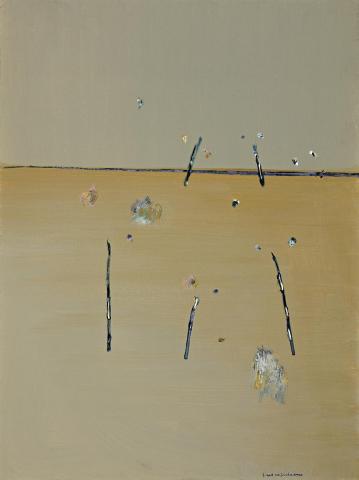GUM TREES IN A LANDSCAPE IV, 1969
FRED WILLIAMS
oil on canvas
122.0 x 91.0 cm
signed lower right: Fred Williams
The estate of the artist, Melbourne
Lyn Williams collection, Melbourne (cat. LW80, label attached verso)
Rex Irwin Art Dealer, Sydney
Private collection, Sydney
Private collection, Sydney
Fred Williams – A Retrospective, Australian National Gallery, Canberra, 31 October 1987 – 31 January 1988;
National Gallery of Victoria, Melbourne, 17 February – 3 April 1988;
Tasmanian Museum and Art Gallery, Hobart, 18 April – 22 May 1988;
Art Gallery of Western Australia, Perth, 13 June – 24 July 1988;
Art Gallery of South Australia, Adelaide, 16 August – 30 October 1988;
Queensland Art Gallery, Brisbane, 24 November 1988 – 30 January 1989;
Museums and Art Galleries of the Northern Territory, Darwin, 29 April – 4 June 1989;
Art Gallery of New South Wales, Sydney, 9 August – 24 September 1989, cat. 119
Fred Williams, Rex Irwin Art Dealer, Sydney, 16 May – 10 June, 2006, cat. 5 (label attached verso)
Melbourne Art Fair, Rex Irwin Art Dealer, 1–5 August 2012 (label attached verso)
Mollison, J., A Singular Vision: The Art of Fred Williams, Australian National Gallery, Canberra, 1989, p. 101 (illus.)
When reviewing Fred Williams's exhibition of November 1969 at Rudy Komon's Gallery in Sydney, James Gleeson wrote, 'In these marvelous paintings Williams proves himself to be the most subtle and penetrating of all our Australian landscape painters.'1 Gleeson, as we all do, wrestled with the paradox that lies at the heart of Williams's art - the seeming simplicity versus the creative complexity, the landscape of monotony and the beauty of its detail. Gleeson continued, 'His theme is the characterlessness of the Australian scrub.' And concluded, 'Only in the individual details can the discerning and sensitive eye discover unexpected beauties.' Mastery of the marvellous, of the complexity and singularity of the Australian bush, realized in high art, requires a simplicity of statement. Therein lay Williams's genius.
A Gum Trees in Landscape was among the fifteen works in the 1969 exhibition, its square format different from our Gum Trees in Landscape a IV in which the vertical composition distinguishes the whole series. Sky and land are subtle fields of colour, across which strokes of paint and their marks add expressive touches - of flat hues decked with expressive whorls of textured paint. The abstract nature of the painting is profound, Williams acknowledging the international (read USA) movements of the time, while firmly fixing his approach in the traditions of Australian art. The landscape is Australia, nowhere else, and as in our various landscapes, close scrutiny is required to discover its beauties. Here, the paradox lies between the vast and the intimate. Moreover, the interplay between the verticals of the tree trunks and the balance of the horizon's horizontal are conceived according to the classical formula, echoing perfection. Williams's friend, the astute scholar James Mollison, wrote about the companion painting Gum Trees in Landscape III, 1969 as having 'been reduced to a few elements, again owing more to the artist's printmaking than to any visual source'.2 He continued 'The landscape, reduced to a few ragged patches and lines, is impersonal and austere. The discipline and restraint suggested in this painting is seen at its most extreme, however, in Gum trees in landscape IV, also of 1969, in which the artist's marks are only just sufficient to suggest landscape.' Austerity can also be read as understatement, the classic understatement that allows the inventive mind to explore on its own terms the ideas touched upon by the artist. Flatness becomes an illusion of depth, like a mirage seen but never reached, objects floating yet fixed. It is in these interchanges, in the harmony between the contrasts of abstraction and landscape figuration within the traditions of Australian art, and sustained by its overall classicism, that the wonderment and beauty of this work lies.
1. Gleeson, J., 'The Williams Paradox', Sun, Sydney, 5 November 1969
2. Mollison, J., A Singular Vision: The Art of Fred Williams, Australian National Gallery, Canberra, 1989, p. 101
DAVID THOMAS
